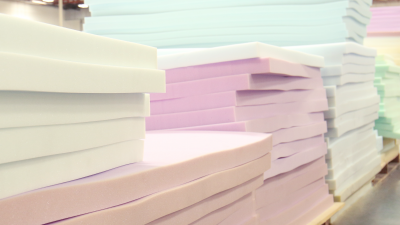Many people with latex allergies assume that they could never use a latex mattress. However, what you may not know is that a latex mattress doesn’t generate an allergic reaction in many latex allergy sufferers. Among the general population, sleeping on a latex mattress has not been shown to cause allergies.
One of the reasons that people with latex allergies may be able to sleep safely on a latex mattress is that the material never comes in direct contact with the individual. That’s because these types of mattresses are usually made up of more than just latex—the latex is just the core of the mattress that provides comfort and support.
Learn more about latex and the construction of this type of mattress so that you can determine what type of latex mattress would be best for you.
What are Latex Mattresses Made From?
There are three types of latex mattresses. Natural latex contains sap from the rubber tree and a few other natural compounds. Synthetic latex is completely man-made and may contain no actual latex. Blended latex mattresses are a mix of the two, and may contain natural latex in addition to synthetic latex foam.
All-Natural Latex
Natural rubber latex uses few ingredients. Rubber tree sap combines with a few other compounds, such as sulfur, and processed to create a foam that’s soft, flexible, durable, and stable. In some cases, there are also natural additives. However, all-natural latex, such as Talalay latex, doesn’t contain any toxic compounds or chemicals.
When people are allergic to latex, they’re usually reacting to the proteins in the natural rubber, not to toxic chemicals in the product. During the vulcanization process that stabilizes latex foam, some of the protein washes out. More of it flushes during open-cell vulcanization than during closed-cell vulcanization.
Synthetic Latex
To make synthetic latex, manufacturers either combine natural with synthetic latex or they create foam using only man-made materials. In that case, no natural latex is involved in the process.
Are Latex Mattresses Hypoallergenic?
You might read online that memory foam or latex mattresses are hypoallergenic. While they are naturally resistant to dust mites, bacteria, mold, and mildew, they’re technically not hypoallergenic.
Types of Latex Allergies
There are two types of latex allergies: type I is an immediate hypersensitivity, and type IV is a delayed hypersensitivity.
People who have a type I latex allergy are sensitive to the proteins in natural latex. It usually generates a systemic reaction as your body releases mast cell histamines to mediate the reaction.
If you have a type IV allergy, you usually react to one of the compounds used in the manufacturing of latex products. This type of allergy usually produces a localized reaction approximately two to four days after exposure. For example, your hands may become itchy or irritated a few days after wearing latex gloves. This type of latex allergy is often called allergic contact dermatitis.
There is a third type of latex sensitivity that’s technically not an allergy. Some people get irritant contact dermatitis, which affects any skin that interacts with latex.
Latex Allergy Symptoms
Latex allergy symptoms vary depending on the type of allergy you have and your level of sensitivity. Some people develop symptoms from skin contact. Others can be affected when they inhale the particles of cornstarch that come off of some latex products.
Some of the most common symptoms include:
- Sneezing
- Skin reactions, such as hives or rash
- Runny nose
- Itching
- Watery eyes
- Difficulty breathing
- Wheezing
- Scratchy throat
Anaphylactic shock is a severe reaction that can cause difficulty breathing, a weak or rapid pulse, dizziness, nausea, and loss of consciousness.
What Causes a Latex Allergy?
Experts aren’t sure what causes a latex allergy. Some people with latex allergies are also sensitive to compounds in certain foods, such as kiwi sand avocados. An allergy is an immune system response that attempts to combat a harmful invader, and its symptoms can range from mild itchiness to a severe drop in blood pressure.
People regularly exposed to soft latex are at a higher risk of developing allergic contact dermatitis or other types of latex allergies. Because of this, individuals who have had numerous surgeries are more prone to developing an allergy.
It’s natural to be concerned about latex allergies and latex mattresses. People with mild latex allergies typically have no problems with latex mattresses because they don’t come in contact with the material itself. Moreover, some types of natural latex go through a process to flush out most of the latex proteins. If you have a latex allergy, talk to an allergist about using a latex mattress.
Is an All-Natural Latex Mattress Safe for People with Allergies?
All-natural latex beds may be safe for people with mild latex allergies. However, you should consult with your doctor, providing them with details about the construction of the mattress.
Most organic companies will provide all of the product details for you, including the materials used. This can help you make a decision.
Birch Living, for example, makes natural latex mattresses and toppers with all-natural materials, such as organic cotton and birch wool. They don’t contain toxic chemicals and won’t off-gas in your home.
They also naturally resist dust mites and mildew. You can read more about the materials used here.
If you have allergies to those environmental elements, sleeping on a Birch mattress could improve your sleep.
The best mattress is one that provides long-lasting comfort and doesn’t exacerbate your allergies. Let your allergist look at the construction of our all-natural latex mattresses to help determine whether our latex beds are perfect for you.














